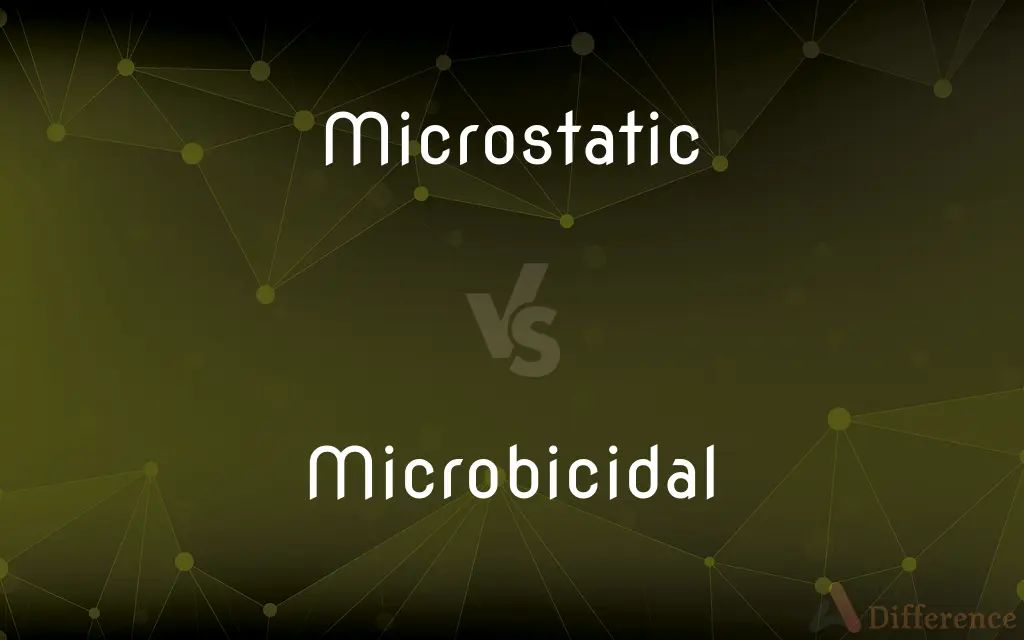Microstatic vs. Microbicidal — What's the Difference?
Edited by Tayyaba Rehman — By Fiza Rafique — Updated on April 20, 2024
Microstatic agents inhibit the growth and reproduction of microbes without killing them, ideal for controlling microbial populations; microbicidal agents kill microbes directly, suitable for eliminating infectious agents.

Difference Between Microstatic and Microbicidal
Table of Contents
ADVERTISEMENT
Key Differences
Microstatic agents work by halting the growth and reproduction of bacteria, fungi, and other microbes. This action doesn't kill the organisms but prevents them from increasing in number, which can be crucial in environments where maintaining balance is important. Microbicidal agents, on the other hand, are designed to kill microbes, making them effective in situations where complete eradication of harmful organisms is necessary.
In medical settings, microstatic drugs are often used when the goal is to suppress microbial activity without causing damage to the host's tissues. Microbicidal drugs are preferred in acute infections where quickly reducing the population of pathogenic microbes is critical.
Microstatic products are commonly utilized in scenarios where long-term management of microbial populations is desired, such as in chronic infection control or in products like preservatives. Microbicidal products find their use in more aggressive treatments, such as disinfectants and antiseptics that aim to sterilize or make environments inhospitable to microbial life.
The mode of action in microstatic agents typically involves interfering with processes vital for microbial growth, such as protein synthesis or DNA replication, without causing lethal damage. Microbicidal agents often disrupt critical structures or functions in microbes, such as cell wall synthesis or membrane integrity, leading to cell death.
Both types of agents are crucial in healthcare for preventing the spread of infections and in managing microbial populations in both clinical and non-clinical settings. Choosing between microstatic and microbicidal depends on the specific needs of the situation, such as whether the presence of microbes poses a threat or their complete elimination is required.
ADVERTISEMENT
Comparison Chart
Action
Inhibits growth and reproduction
Kills microbes
Use Case
Long-term management and control
Immediate eradication needed
Typical Applications
Chronic infection control, preservatives
Disinfectants, antiseptics
Impact on Microbes
Halts biological processes without killing
Disrupts and destroys cell structures
Desired Outcome
Control and containment of microbial growth
Complete elimination of harmful microbes
Compare with Definitions
Microstatic
Important in environments where balance is crucial.
Microstatic treatments are used in ecosystems to control pathogen populations without disrupting other microbial activities.
Microbicidal
Refers to substances or agents that kill microbes.
The surface cleaner is microbicidal, ensuring that all germs are eradicated.
Microstatic
Used to describe substances that do not kill microbes but prevent their growth.
Microstatic compounds are essential in the formulation of some chronic disease medications.
Microbicidal
Agents that can destroy bacteria, viruses, and fungi.
His research focuses on developing a new microbicidal compound that targets resistant bacterial strains.
Microstatic
Suitable for managing microbial presence.
Microstatic methods are often preferred in sensitive applications where killing microbes might be too disruptive.
Microbicidal
Often stronger and more aggressive than microstatic agents.
For surgical instruments, a microbicidal wash is mandatory to prevent any risk of infection.
Microstatic
Agents that prevent microbial proliferation.
Certain preservatives in food are microstatic, extending shelf life by preventing mold growth.
Microbicidal
Effective for immediate removal of infectious agents.
In outbreak scenarios, microbicidal solutions are critical for quick decontamination.
Microstatic
Pertaining to the inhibition of growth and reproduction of microbes.
The doctor prescribed a microstatic antibiotic to manage the infection without harming beneficial bacteria.
Microbicidal
Used in medical and industrial settings for sterilization.
Microbicidal sprays are used in hospitals to maintain a sterile environment.
Microstatic
Of or relating to an agent that prevents a colony of microbes from increasing in size.
Microbicidal
Of, pertaining to, or functioning as a microbicide
Microbicidal
Such a material
Common Curiosities
Are microbicidal agents always preferable in hospital settings?
Not always; microstatic agents may be preferable in situations where preserving beneficial microbial flora is important, but microbicidal agents are crucial for sterilization and during outbreaks.
What are the risks associated with using microbicidal agents?
They can lead to resistance in microbes if overused or misused, and may also harm beneficial microbes in and on the body.
What is the primary difference between microstatic and microbicidal agents?
Microstatic agents inhibit growth and reproduction, while microbicidal agents kill microbes outright.
Can microstatic agents lead to microbial resistance?
Yes, microbes can develop resistance to microstatic agents, although this might occur at a different pace or mechanism compared to microbicidal agents.
When would you use a microstatic agent over a microbicidal one?
A microstatic agent is used when you need to control microbial growth without necessarily killing the microbes, such as in chronic infection management.
What environmental considerations are there for using microbicidal agents?
Microbicidal agents can be harmful to the environment if not used properly, as they can kill a wide range of microbes, including those beneficial to ecosystem processes.
How do microstatic agents work at the cellular level?
They typically interfere with essential functions such as DNA replication or protein synthesis, which are crucial for microbial growth.
Is there a place for microstatic agents in the treatment of viral infections?
Yes, microstatic agents can be used to manage viral replication in chronic viral infections like HIV.
Can a substance be both microstatic and microbicidal?
Yes, some substances can act as both, depending on the concentration used and the specific microorganism.
Can using microstatic agents prolong the effectiveness of microbicidal agents?
Yes, using microstatic agents can help manage microbial populations and reduce the frequency of needing microbicidal interventions.
How do safety profiles of microstatic and microbicidal agents compare?
Microstatic agents generally have a safer profile as they are less disruptive to natural and beneficial microbial flora.
What are some common microbicidal agents found in everyday products?
Alcohol in hand sanitizers and bleach in household cleaners are common examples of microbicidal agents.
What are the global implications of overusing microbicidal agents?
Overuse can lead to increased microbial resistance, making infections harder to treat and control globally.
How do industries choose between microstatic and microbicidal treatments?
Choice depends on the specific requirements of hygiene, longevity of effect, and the nature of the microbial threat.
What advancements are being made in the development of microbicidal agents?
Research is focusing on creating more specific and less resistance-prone microbicidal agents.
Share Your Discovery

Previous Comparison
Babe vs. Darling
Next Comparison
Challenging vs. ChallengeableAuthor Spotlight
Written by
Fiza RafiqueFiza Rafique is a skilled content writer at AskDifference.com, where she meticulously refines and enhances written pieces. Drawing from her vast editorial expertise, Fiza ensures clarity, accuracy, and precision in every article. Passionate about language, she continually seeks to elevate the quality of content for readers worldwide.
Edited by
Tayyaba RehmanTayyaba Rehman is a distinguished writer, currently serving as a primary contributor to askdifference.com. As a researcher in semantics and etymology, Tayyaba's passion for the complexity of languages and their distinctions has found a perfect home on the platform. Tayyaba delves into the intricacies of language, distinguishing between commonly confused words and phrases, thereby providing clarity for readers worldwide.














































